Posted by MAXIMUM SLIM on Aug 5th 2024
The Best Intermittent Fasting Schedule To Consider For Your Goals And Lifestyle
Many weight loss plans involve tracking what you eat, but intermittent fasting (IF) tracks when you eat. intermittent fasting consists of "eating windows"—when you can theoretically eat whatever you want—and fasting periods, when you're supposed to abstain from food, but you're allowed to have water, coffee, and tea. The duration of your eating and fasting windows depends on which intermittent fasting schedule you follow.
First: Can intermittent
fasting really help with weight loss? Some research has shown intermittent fasting may
result in weight loss. Limiting your
"eating hours" may result in fewer calories consumed, which will
assist in a healthier lifestyle goal. However, intermittent fasting
may help with focus and concentration. By being in a fasted state, our bodies
can focus on the tasks at hand instead of breaking down food.
With that said, intermittent
fasting is not for everyone, and the last thing you want to do is
stick to a plan that's unsustainable (or doesn't work for your schedule). It's not
a good idea for anyone with a history of disordered eating or diabetes and
those who are pregnant or breastfeeding—even if weight loss is recommended.
Also, if your schedule is sporadic or you work out at various times of the day,
you might want to reconsider intermittent
fasting.
So, who should try it? If you tend to overeat at night or are looking for a bit more discipline, intermittent fasting may help prevent mindless eating through the day. It might also be a good option if you've tried creating a calorie deficit in the past, but it didn't work. Practicing intermittent fasting may benefit those individuals who struggle to eat breakfast or prefer to eat later in the day. Ultimately someone should choose to practice intermittent fasting if it works for them, but most importantly if it makes them feel good.
The 16:8 method (more on that below) is the most popular route. But there are plenty of other options to choose from. Here are six of the most popular intermittent fasting approaches that people tend to follow for weight loss—and what research says about each one.
1. The 16:8 diet
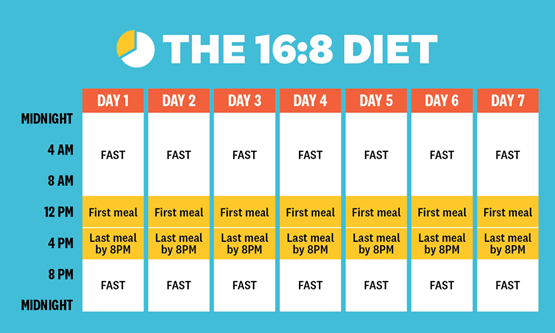
The 16:8 method of intermittent fasting involves fasting every day for 16 hours and restricting your daily eating window to eight hours. For most people, this schedule means not eating anything after dinner and skipping breakfast. You might eat between, say, noon and 8 p.m.
If you like working out in the morning, we suggest opting for a schedule that's more accommodating than this one (see the 14:10 diet). But if you prefer to get in your workouts during the late afternoon or after 5 p.m., you'll still have time to eat after your workout to refuel with a meal.
How does the 16:8 method fare for weight loss? It could work!
One example: Twenty-three obese men and women followed the 16:8 diet for 12 weeks in a small. Compared to a group that had eaten normally and not within a set timeframe, those on the 16:8 diet took in 350 fewer calories per day, lost a modest amount of weight (about three percent of their body weight on average), and lowered their blood pressure.
Interestingly, following this kind of eating plan may help with appetite control. People who ate only during a six-hour window versus those following a normal eating schedule felt less hungry, even though both groups ate the same number of calories.
2. The 5:2 method
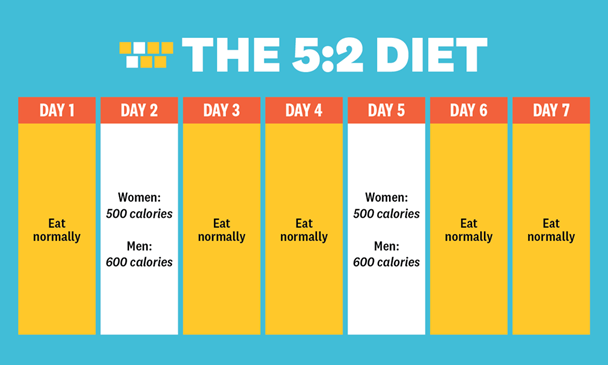
To follow the 5:2 diet, you eat normally five days a week and cut back to 20 percent of your normal daily calorie intake for the other two. Note: Women are supposed to have about 500 calories on fasting days, while men have about 600.
Can you Drink Coffee While Intermittent Fasting?
You burn calories every minute you're alive, including when you're sleeping. When you snooze, your body utilizes the glycogen stored in your liver to keep your blood sugar levels stable. So, your body is already familiar with the mechanisms of fasting.
Your body is designed to compensate when energy is not coming in from food. The concept of something like fasting is to prolong that period where you're relying on your internal backup system to fuel you.
This intermittent fasting method results in just as much weight and fat loss as those who followed traditional dieting methods.
Use coupon code ESPRESSO to get 20% off your Organic Espresso
3. Alternate-day fasting
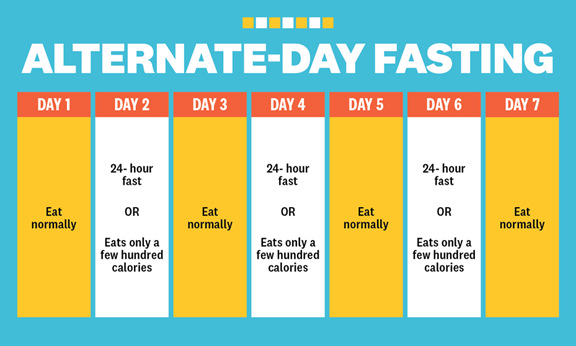
As the name implies, this diet involves fasting every other day. There are several different versions of this plan, with some of them allowing about 500 calories on the fasting days, and some encouraging that you eat even fewer or close to zero calories on fasting days.
Much of the weight loss-focused research hasn't been conclusive. And this style of intermittent fasting was deemed not superior to a calorie-restricted diet in terms of weight loss or maintenance.
intermittent fasting schedules that require 24 hours of fasting are harder to stick to and people tend to experience more side effects, including mood swings and hunger. So, only try this if you have done intermittent fasting before and are willing to track your calorie intake and cut down the intensity of your workouts on fasting days to avoid injury.
4. Eat-stop-eat diet
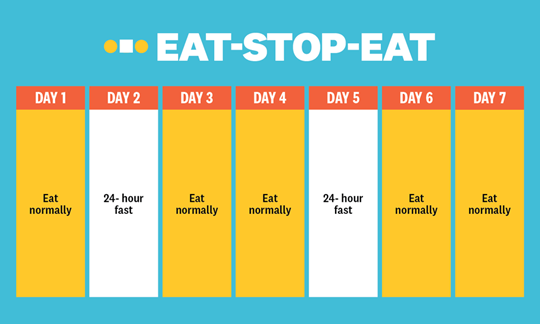
This method of intermittent fasting involves a full fast for 24 hours once or twice a week. For example, you may eat dinner at 6 p.m. and then fast until 6 p.m. the next day. And you would do this one or two times per week—but not in a row.
Keep in mind that not eating for an entire day can be dangerous under certain circumstances and should not be taken lightly. While the weight-loss potential might be appealing, skipping full days of eating is not sustainable long-term.
If you are knocking out two full days of eating, I would worry that the longer you do that, the greater at risk you would be for certain micronutrient deficiencies.
5. The 14:10 diet
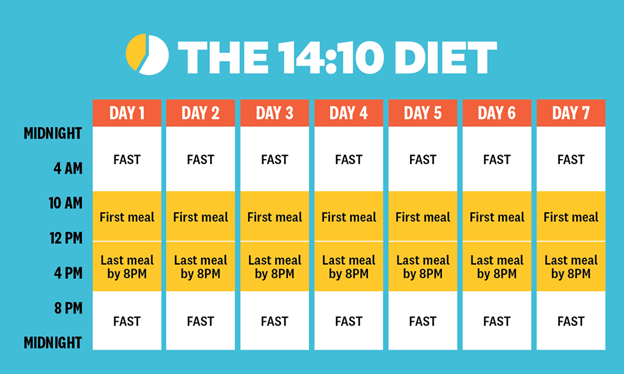
This one is like the 16:8 method but involves fasting for a 14-hour window and eating for 10. It's a little easier to stick to than 16:8 because you have a longer eating window. But that doesn't mean it's not effective.
In fact, those who followed the 14:10 diet while incorporating nutritious foods and consistent exercise lost more weight than those who did the 12:12 diet. They also showed a more significant improvement in blood glucose levels after eight weeks.
Given that the fasting period is short and pretty much follows the way people already eat, it may be hard for some people to achieve a calorie deficit with this diet. Still, it could be a good way to ease intermittent fasting if you're new to it and want to see how you do when you have a specific timeframe for eating. It's also a great option if you like to get your workouts in between 8 a.m. and 10 a.m.
6. The Warrior Diet
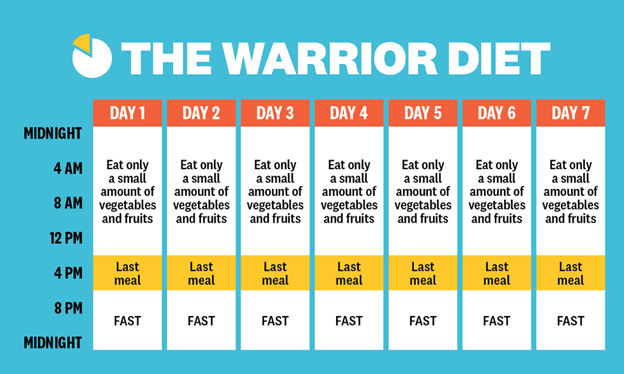
This diet is way different from the rest, with most of the eating happening at night. It involves eating only small portions of raw fruits and vegetables during the day, then feasting on one huge meal at night within a 4-hour eating window, between 4pm and 8pm.
While the fasting periods still allow for some food, the period when you can have heavier foods is very short, and the diet also involves focusing on paleo foods, so it's stricter than other forms of intermittent fasting.
And like the eat-stop-eat diet, this option is not sustainable long-term. There's no way you're going to meet your nutrient needs eating this little food. Your energy levels would suffer and you're basically asking to overeat. You're just going to hurt yourself if you go this route.
What are the benefits of intermittent fasting?
The initial findings are promising. Here are the potential benefits of intermittent fasting based on recent studies.
- Intermittent fasting may reduce insulin levels, fat mass, and the risk of developing age-related diseases in those that are overweight.
- Intermittent fasting may help prevent short-term and long-term memory loss.
- Intermittent fasting could aid in the treatment and prevention of obesity.

Which intermittent fasting schedule is best for weight loss?
In short, the one that's easiest for you to follow. It is all about sustainability for the individual. If one of these diets works well for you and your lifestyle and preferences, then you will likely see some success. If not, then you'll likely not see the results you're looking for, as the sustainability piece will not be there. That means picking a diet that works best with all the lifestyle factors you need to consider, like your work schedule, family dynamic, living situation, commute time, and travel commitments.



